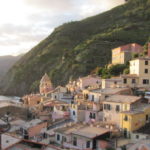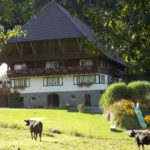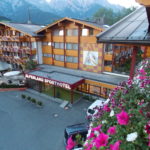You can greatly enhance your experience with good choices for where to stay in Europe. My husband and I have differing views. His view is that where he sleeps is less important and he would rather save some money to spend on other aspects of a trip. I don’t totally disagree with this view. However, I believe that there are several aspects of our accommodations that are vitally important, chief among them location. I also believe that the type of property you choose can be a highlight of your trip. Some examples of places we have stayed incude:
- London, England – a boutique hotel within a quarter-mile of two tube stations and Hyde Park that had originally been a townhome built by King Edward for his mistress, the actress Lilly Langtree
- Lakes District, England – a sheep farm B&B dating back to the early 1700’s with scenic views of the valley and charming hosts and fellow guests
- Vernazza, Italy – a private rented room with stunning views of the Mediterranean, town, and vineyards
- Nice, France – hotel with a room overlooking the Mediterranean, right across the street from the beach
- Rudesheim, Germany – studio apartment in the heart of town, just a block from the party street Drosselgasse
- Black Forest, Germany – working farm with cows grazing just below our private balcony
- Ireland & England – small B&B’s with congenial hosts serving up the traditional Irish or English breakfast
- Ireland – Ashford Castle
- Austrian Alps – Ski Hotel Resort










None of these places broke the budget, i.e., they were accommodated within my self-imposed average $120 per night rate for a trip. Some cost more than that and some less but in all cases, the entire trip came in on budget. Each of these places were conveniently located to what we wanted to do and some became trip highlights themselves. How do you find these places?
Choosing Where to Stay in Europe
In previous posts, I have mentioned that before choosing hotels, you need to have a good idea of what you want to do. This is where location becomes important as you don’t want to spend more time getting to your activities than enjoying them. The decisions you have already made on experiences you want to have and on your mode(s) of transportion are key in deciding where to stay in Europe.
Step 1: Choosing Location
If you are following my planning approach, you have already mapped out your itinerary and your transportation approach. So you have a good idea about where to stay in Europe. To help you narrown down further you now need to consider the following:
Inside Big Cities (most expensive) – You need to pick a neighborhood. European big cities are broken down into well-defined areas. The neighborhood you choose should be convenient to the museums and other activities you want to experience. It should also be safe, convenient to public transportation, and have good restaurants, shopping, and nightlife within walking distance. In London, our hotel was a walk through Hyde Park away from Buckingham Palace and close to two different tube lines providing easy access to other parts of the city. In Rome, our B&B was just a couple of blocks from the Colliseum. In Berlin, we stayed in the Mitte neighborhood with numerous restaurants and convenient public transportation options. In Lyon, our hotel was just across the river from Vieux Lyon and a few blocks from their major shopping area. Hotels, B&B’s, and apartment stays are your primary options.
Near Big Cities – You may prefer to stay outside city limits and commute in. This will save you money on your accommodations but may cost you in time, depending on what you want to do and how much time you want to spend within the city. You will also increase your choices for types of accommodations to include villas, castles, and farmstays. Transportation choices are important. How will you get into the city and to the specific places you want to go? If you drive, you will need to think about traffic, parking and parking fees in the city. If you are not driving, what are your public transportation options – are they within walking distance of your room and how late do they operate? We have had good experiences with this option as well. In Florence, I have stayed on both an agriturismo and in a 400-year-old villa. In Munich, our hotel was out closer to the airport but the trains were within a 15 minute walk and ran all night so we were easily able to get to the Oktoberfest grounds. In Trier, Germany our hotel was outside of town but up on a hill with a scenic view of the city which was a 10-minute drive away.
Smaller Towns – Your choices here depend on whether the town itself is your destination or whether it is your home base for regional exploration. In either case, it’s always nice to be close to restaurants and shops. If the latter, ease of getting in and out of town is a consideration. You will find small hotels, B&B’s guesthouses (with shared kitchens), and apartments. Costs vary greatly. Towns that are tourist hubs like Rothenburg ob der Tauber or towns on the French or Italian Rivieras are more expensive.
Rural Stays (least expensive) – These can be close to cities and towns or they can be remote and destinations unto themselves. You usually need a car to get to them but they can be great bases for exploration and provide an opportunity to immerse yourself in local culture.
Resorts – Timeshares and other types of resorts can be found all over Europe. They come with amenities that other types of accommodations often don’t, like swimming pools, on-site restaurants, and planned activities. They often cater to families with children and people tend to stay at resorts for more than a night or two (often for an entire week). If you are a member of a timeshare network (i.e., Interval International or RCI) this can be an economical choice. However, your choices are more limited, they tend to be in fairly remote but touristy areas, and it may take months to secure one. I own a timeshare in the Interval International network and have traded for resorts in Southern Italy, the Costa del Sol, the Austrian Alps, and Normandy. All provided memorable experiences and worked well as bases for exploration.
Step 2: Choosing Your Accommodations
Now that you’ve got a good idea about where to stay in Europe, it’s time to look at properties. My approach is a combination of online research and guide book referrals.
There are a number of ways to conduct your online research.
- You can type in a search for properties in particular cities or regions and see what comes up. You will see several options including tourist information sites for the areas you are searching in, consolidators like Booking.com, and review sites like TripAdvisor.com.
- You can look up individual properties you find in the guide books. This is more time-consuming and will take you to either the property’s own website or to the property’s listing on Booking.com or a similar site.
- You can go to sites for specialized properties like www.agriturismo.net for farmstays in Italy or www.gites-de-france.com for similar properties in France.
- You can search on AirB&B.
I find that the most efficient approach is to go directly to Booking.com. They have all varieties of properties in their database and you can use filters and maps to hone in on those that meet your criteria. You can also then look through your search results for properties listed in guide books. If a property is in both places, that’s an indicator that you are making a good choice.
When researching properties, I always look at the following:
- Reviews – I read dozens for each property that looks promising. This is the best way to find out why a property may be rated a particular way. For example, a property may be rated only two stars but many of the reviewers rate it that way for the same reason – i.e., rooms are too small, no air conditioning or elevators, etc. If those reasons don’t matter to you, you may have found an economical property that will work quite well for you.
- Location – How convenient to restaurants, shopping, attractions, and, if relevant, public transportation is the property? How safe is the immediate vicinity? The reviews will answer a lot of these questions.
- What’s included – Private or shared bathroom? Breakfast? Parking? Internet? etc.
- Ownership – My preference is to stay away from American hotel chains in Europe, preferring local ownership to feel more in tune with the local culture. This may or may not matter to you.
Some people advocate that you can get better deals by dealing directly with the properties via their website, email or phone. I have found that to be true in some cases but the variance in price is little enough that it doesn’t outweigh the convenience (to me) of having all my reservations in one place where it is easy to make changes with a few clicks.
Step 3: Booking Your Accommodations
Whether you choose to go through a consolidator like Booking.com or direct to the property, there are a couple of things to consider when booking where to stay in Europe.
- How far in advance should you book? For high demand places at high demand times – i.e., Oktoberfest in Munich or summer on the Riviera – you should book well in advance to have the most choices and get the best rates. I would recommend booking as far as six months out if not more. I booked our hotel in Munich in February for the opening weekend of Oktoberfest in September.
- How firm are your plans? You may be surprised at how quickly available rooms can disappear if you don’t grab them when you see them. I always look at the cancellation clauses. Within the consolidators, be careful of this as some really good rates do not allow you to cancel without paying. Often, but not always, rooms with free cancellation have slightly higher prices. If this still allows me to come in on budget, I go for these because you just never know what may change. For example, our recent trip to Germany had us staying in Koblenz when we were planning train and boat travel from Berlin to the Rhein River area. When we decided to drive instead, we changed our reservations to Trier because we no longer needed the convenience of Koblenz and we had been there before.
Step 4: Documenting Your Choices
Again, if you have been following my research and planning approach, you have been creating a PowerPoint deck documenting your plans. This is another chapter. I create two types of pages for accommodations.
First, I create a page listing each property with a brief summary and the dates that have been booked.

The second type of page is a more detailed page for each property, including details of what’s included, price, description, and a relevant review.

Have fun with your research. Be open to all the possibilities and you can have a truly memorable experience in Europe.